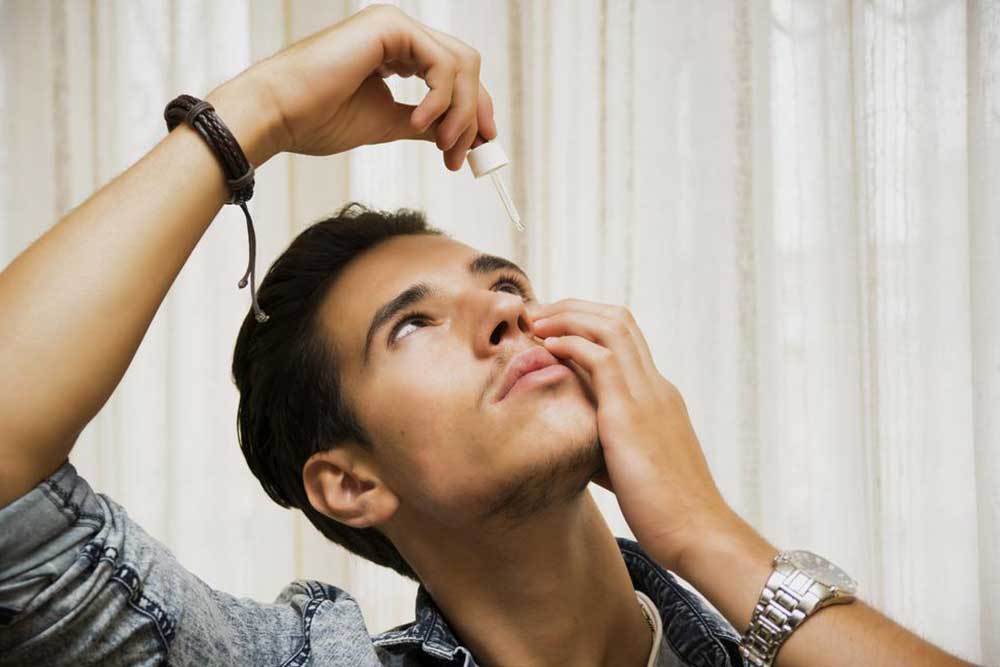Red Eyes – Common Symptoms, Causes, and Treatment
Red eyes refer to a condition in which the white portion of the eye, known as sclera, becomes reddened or “bloodshot.” The redness occurs when the vessels in the eye become inflamed or irritated. Redness in the eye can manifest in various ways ranging from the occurrence of squiggly pink dots on some part of the sclera to the development of lines in the entire sclera.
Red eye can happen in either one or both the eyes.

A few symptoms associated with red eyes are as follows:
- Irritation
- Dryness
- Itching
- Pain
- Watery eyes
- Blurry vision
- Burning sensation
- Sensitivity to light
Common causes of red bloodshot eyes
There are several allergens present in the environment that can trigger red eye. These allergens include the following.
- Airborne allergens
- Pollution in the air caused by smoke
- Dry air in airplane cabins, closed office buildings, or arid climate
- Dust
- Airborne fumes generating from gasoline or solvents
- Chemical exposure caused by chlorine in swimming pools
- Excessive exposure to sunlight, for example, going out without wearing UV-blocking sunglasses
Some serious eye conditions that can cause red eyes are as follows:
- Eye trauma or injury
- Eye infection
- Conjunctivitis
- Recent eye surgery including cosmetic eye surgery or laser treatment
- Scleritis, in which the sclera becomes excessively swollen and red
- Uveitis
- Acute glaucoma
- Corneal ulcer
Few lifestyle factors can also trigger red eyes, such as the following.
- Smoking marijuana or tobacco
- Excessive alcohol consumption
- Continual use of digital devices
- Inadequate sleep
Red eye treatment
Simple measures can help treat red eyes. Some of these measures are as follows:
- Avoid rubbing eyes as it promotes mast cell degranulation and histamine release. Instead, you can use cool compresses to alleviate itching.
- In order to ease mild red eye symptoms, you need to close your eyes and splash cold water several times a day onto your eyelids. This causes the blood vessels to constrict and thus help to cool and lubricate the eyes.
- Use a cold towel on your eyes during the daytime. This will have a soothing effect on the eyes and make them less sore. In addition, you can use cucumber, teabags or cooled masks.
- Effective red eye treatment for relieving the symptoms is to place two cotton balls in cold skim milk. Squeeze them out and put them on the eyelids for nearly ten minutes.
- Warm compresses on the eye can also help to reduce the redness.
- Wash your hands often and do not touch your eyes until your hands are thoroughly clean. Also, use clean bedding and towels daily.
- Since lack of sleep and rest can make your eyes red and sore, it is best to sleep for at least 7 to 8 hours a night. It is very important to rest after sitting on the computer consistently.
- It is important to avoid irritants such as smoke, dust, pollen, the fur of animals, and arid climates.
- Increasing the intake of vitamins and consuming a nutritious diet can also prove to be an effective red eye treatment. Add a multivitamin supplement to your diet. Take vitamin C, which is a natural antihistamine. Oranges and vitamin C supplements aid in relieving unpleasant symptoms.
- Omega-3 is also anticipated to play a substantial role in stabilizing the tear film and this may help your eyes. Take Lutein, blueberry or vitamin A and B supplements. You may also take grape seed extract as it contains antioxidants, which strengthen the blood vessels in the eyes. Glucosamine amino acid strengthens elastin and collagen tissues and prevents redness.
- Use over-the-counter artificial tears. However, consult a doctor before using one.
These days, a range of different eyes drops is available in the market. However, eye drops can only be used occasionally. The chemicals present in these eye drops constrict the blood vessels in the eyes. This reduces the redness in the eyes. But, if you use them frequently or over an extended period, the eyes will become redder than they already were. Also, the vasoconstrictors, which minimize redness by contracting the eye’s blood vessels are addictive. So, it is best to use them only occasionally as a red eye treatment option.
It is seen that viral eye infections, which are common, tend to improve on their own, and do not require prescription treatment. Bacterial eye infections, on the other hand, require a proper course of antibiotics. However, both the types of infection are highly transmissible.
Seek medical help
It is best to get professional advice from an ophthalmologist, who knows what red eye treatment is the best for you. Red eyes are generally a short-term problem. If the problems persist for more than three days, you should seek immediate help.
Until you can consult your eye doctor for red eye treatment, wear your glasses so that the infection is not spread. In addition, moisten your eyes frequently with preservative-free lubricating eye drops to ease the symptoms.




